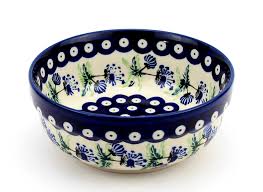
Design Takeaways: Bolesławiec Pottery
Share
A Brief History of Polish Pottery
The tradition of Polish pottery, most famously associated with the town of Bolesławiec, goes back to the 14th century, but it wasn’t until the 18th and 19th centuries that the style truly matured into what we know today: creamy white stoneware decorated with hand-stamped patterns, high-fired for toughness and lovingly finished with a glossy glaze.
These pieces are a regional art form, a utilitarian marvel, and a cultural export that still resonates with collectors and home cooks alike.

Let’s unpack what makes Polish pottery more than just grandma-chic tableware, and which details we should pay attention to as we design the next generation of thoughtful, emotionally resonant product design.
Repetition is a Brand Language
Those tiny dots, flowers, and peacock feathers you see aren’t just done on a whim, they’re pattern systems. Hand-stamped using sponge-cut motifs, these designs create consistency across product lines, allowing for endless variation within a recognizable visual DNA. It reminds us to use repetition not to bore, but to bind. Whether it’s stacking bowls or a smart home appliance line, establishing a repeatable visual grammar makes for a stronger, more flexible brand.

Function Comes First (but Aesthetics Sneak In with a Wink)
These are not dainty pieces for the shelf. Polish pottery bowls are hefty, mugs are stable, and casseroles go from oven to table without flinching. The thick walls and rounded corners scream "I’ll be here long after your non-stick pan gives up. It's a daily reminder that we need to make it work, and then make it wonderful. Polish pottery is proof that sturdiness and beauty can cohabitate.

Cultural Context is the Secret Ingredient
From the peacock motif (a regional symbol of prosperity) to the bold color palettes, every design choice is rooted in regional tradition. It’s like the piece is saying: “Hi, I’m from Bolesławiec. Here’s a little story in pattern form.” We must root our products in story. Even a trendy appliance can have a backstory if you let it. Customers connect more deeply with designs that feel grounded in something larger than trend cycles.

Bringing It Forward: Modern Interpretations
The great thing about Polish pottery is that it doesn’t have to live solely in the past. Its principles of pattern systems, cultural storytelling, and rugged elegance are entirely translatable to modern design challenges.
Polish pottery reminds us that design can be joyful, expressive, and functional without giving up its roots. It’s not chasing minimalism, it’s sitting in the kitchen, proudly patterned, inviting you to slow down and appreciate a rich culture and their history.
So, whether you’re prototyping the next kitchen hero product or trying to bring soul to a modern tabletop line, remember: a little pattern, a lot of purpose, and a dash of cultural continuity can take your work a long way.
And if all else fails, add some peacock feathers. They’ve been working for 700 years.
